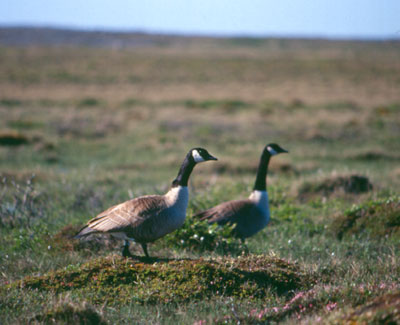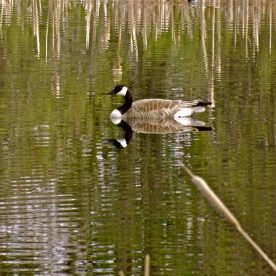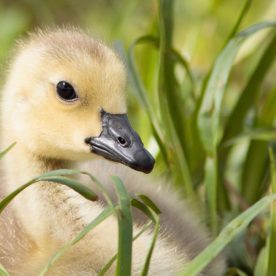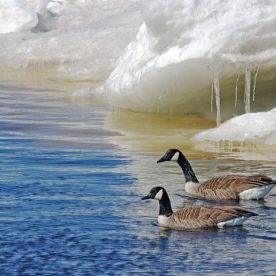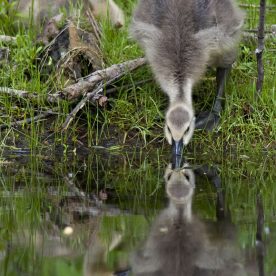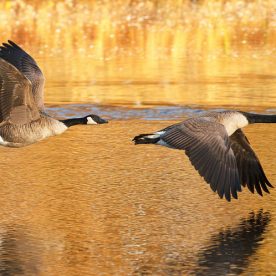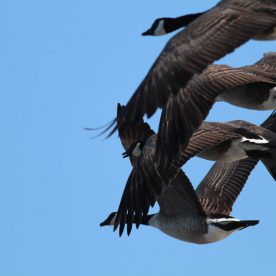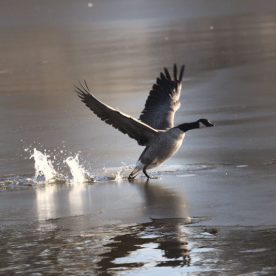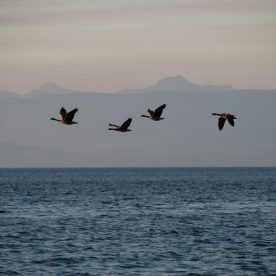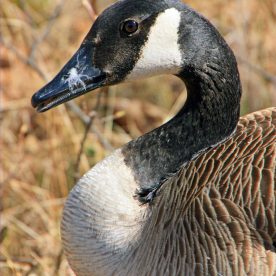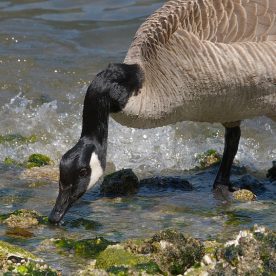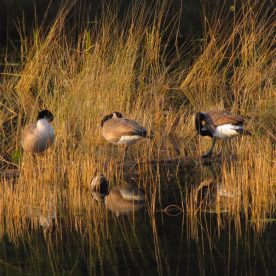Description
Many people can recognize a Canada Goose Branta canadensis by its characteristic black head, white cheek patches, and long black neck. However, there are several different races, so a Canada Goose in one region may be quite different from a Canada Goose in another. Although there has been some disagreement about the exact number of races of Canada Geese, most scientists believe that there are 11.
Members of the different races range in size from one of the smallest geese, the Cackling Canada Goose, which can weigh as little as 1.1 kg, to the largest of all geese, the Giant Canada Goose, which can weigh up to 8 kg. Wingspans vary between about 90 cm and 2 m. The underparts range in colour from light pearl-grey to chestnut, and even blackish brown. Differences in body proportions, particularly the relative length of the neck, the body shape, and the body stance, further distinguish the different races. In general, the larger the bird, the longer the neck and the more elongated the body. Please note: Four former races of Canada Goose are now considered a separate species, the Cackling Goose. These geese all breed in the Arctic, and in general, they are smaller than Canada Geese. A revised version of this fact sheet reflecting this change will be posted soon.
Newly hatched Canada Geese have a coat of yellow to olive down that darkens to dull grey over the first few weeks of life. As the birds grow, feathers gradually cover the down, and by the time the young geese are ready to fly in late summer, they are nearly indistinguishable from their parents. From that point on, both males and females look the same throughout the year.
Signs and sounds
Flocks of migrating Canada Geese are readily recognized by their irregular “V” formation as they pass overhead in spring and fall. They can often be heard as well, since there is usually a steady chorus of honking. Their calls range from the deep ka-lunk of the medium and large races to the high-pitched cackling voices of smaller races. Researchers have determined that Canada Geese have about 13 different calls ranging from loud greeting and alarm calls to the low clucks and murmurs of feeding geese.
Goslings begin communicating with their parents while still in the egg. Their calls are limited to greeting “peeps,” distress calls, and high-pitched trills signalling contentment. Goslings respond in different ways to different adult calls, indicating that the adults use a variety of calls with a range of meanings to communicate with their young.
Habitat and Habits
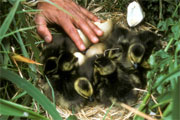
You can find Canada Geese on almost any type of wetland, from small ponds to large lakes and rivers. However, Canada Geese spend as much or more time on land as they do in water.
Canada Geese breed in a wide range of habitats. They prefer low-lying areas with great expanses of wet grassy meadows and an abundance of ponds and lakes that serve as refuges from foxes and other land predators. The most northerly geese breed on the treeless tundra of the Arctic. Below the treeline, the geese nest in the open boreal forest, with its scattered stands of stunted spruce and tamarack. In southern Canada and throughout the United States, nesting Canada Geese are at home in many places, from sheltered mountain streams and prairie pothole ponds to golf courses and urban parks. During fall and winter, Canada Geese favour agricultural land where vast fields of cereal grains and other crops provide abundant food and relative safety from predators.
Family bonds are strong in Canada Geese—goslings stay with their parents for a full year, returning to the breeding grounds with them after their first winter. Migrating flocks in fall and spring thus consist of a number of families travelling together.
While most Canada Geese are territorial during the nesting period, they congregate in flocks of several hundred to several thousand when they are migrating or are on the wintering areas.
Unique characteristics
The spectacle of Canada Geese migrating in long, honking, irregular “V” formations across spring or autumn skies is always thrilling. It is one of the most dramatic portents of the change of seasons in Canada. Flying in diagonal lines or “V” formations serves at least two purposes. The most important is that it helps the geese save energy and permits them to fly longer distances. Scientists believe that Canada Geese fly in a “V” because of the “drafting” effect, where the follower goose, like a cyclist in a race, benefits from the air currents passing the leader, and thus expends less energy flying. A secondary function of the formation is to coordinate the flock’s movements, allowing changes in flight speed or direction to be communicated quickly and efficiently to all members of the flock.
Range
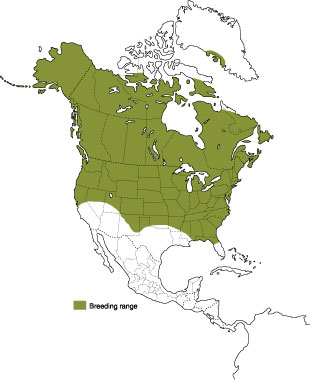
Canada Geese breed throughout North America, except in the high Arctic and in the extreme southern parts of the United States and Mexico. Part of the North Atlantic population even nests in western Greenland. Some winter in southern Canada from British Columbia to southwestern Ontario to the Maritime provinces, as long as they can find food and open water, but the great majority travel farther south to the United States, or even to northeastern Mexico.
Spring migration for northern-breeding geese begins in late winter and may take several weeks to complete. The geese move slowly northward following the advancing line of melting snow. They make several feeding stops at key areas along the way to build up reserves that will be needed for the final leg of migration and reproduction.
Fall migration begins when the water and soil begin to freeze on the breeding grounds. The trip from breeding to wintering areas is faster than the spring flight north. For example, many Atlantic population Canada Geese travel more than 1 000 km from their breeding grounds in northern Quebec to the main wintering area along the United States eastern seaboard in less than a week. In fact, scientists have tracked some geese marked with radio transmitters that have completed the trip in just one day! Families with goslings migrating south for the first time probably take longer than adults without goslings.
In addition to the annual migration from breeding to wintering grounds, Canada Geese sometimes undertake a special voyage called a moult migration. Every year, geese must replace their worn-out flight feathers. The feathers are replaced all at once, so the geese cannot fly during the four- to five-week moulting period. The best places for the geese during this time are those with lots of open water where the birds can seek refuge if threatened and where they may find a good supply of the protein-rich food needed for growing new feathers. Most of the geese that don’t breed during the season undertake this migration, which usually involves travelling north, often well beyond the normal breeding range, between late May and early June. Successful breeders moult later in the season, remaining with their young goslings, which have not begun to fly.
Feeding
Unlike many waterfowl species that feed mainly in aquatic environments, Canada Geese feed mostly on land. In spring and summer, they mostly graze on the leaves of grassy plants, but they also eat a wide variety of leaves, flowers, stems, roots, seeds, and berries. The geese must consume large quantities of food to obtain the nutrients they need, and they frequently spend 12 hours a day or more feeding. During the winter, Canada Geese often feed in fields where they find an abundance of spilled corn, oats, soybeans, and other crops. When such energy-rich foods are available, they often feed in the fields for a few hours in early morning and late afternoon and spend the rest of the day resting in safety on a lake or large river. Some Canada Geese graze on lawns, in parks, and on golf courses.
Spring is a very energetically demanding time in a goose’s life, especially for breeding females. Canada Geese feed intensively during the few weeks before they leave southern agricultural areas to prepare for a period with little food when they first arrive on the northern breeding grounds. They will need sufficient reserves of fat and protein to complete migration, produce a clutch of eggs, and survive for about one month of incubation.
Breeding
The Canada Goose finds a mate during its second year and once paired, the geese remain together for life. Contrary to popular belief, however, if one member of the pair is killed, the other will find a new mate.
Canada Geese breed earlier in the season than many birds. Breeding is timed so that the eggs hatch when the plants that the goslings, or young geese, eat have their highest nutritional value. The hatch date also allows enough time for the goslings to grow big enough to fly south before freeze-up. Canada Geese that breed in temperate areas, with mild temperatures, begin nesting as soon as conditions are favourable in spring, in some cases as early as mid-March. Canada Geese that breed in the north reach nesting areas in late April or early May, later for Arctic breeders.
Some Canada Geese breed when they are one year old, but the vast majority do not nest for the first time until they are at least two or three. Usually five to seven eggs are laid, with older birds producing more eggs than birds nesting for the first time. The female incubates the eggs for 25 to 28 days while the male stands guard nearby. In some cases, he may be several hundred metres from the nest but is always vigilant and joins the female if the nest is threatened or if she leaves the nest. During the incubation period the female leaves the nest only briefly each day to feed and drink and bathe.
Most nest sites are located near water and often on islands. Nest sites are chosen to offer some protection from exposure to wind while giving the incubating female a clear line of sight to detect approaching predators. Female Canada Geese always return to nest in the same area where their parents nested and often use the same nest site year after year.
Soon after the young have hatched, families leave their nests, sometimes walking several kilometres in a few days to reach their brood-rearing area. If the geese have nested near the seacoast, they may descend the rivers to more favourable coastal marsh areas. From the moment they leave the nest, goslings feed on grasses and sedges in meadows and along shorelines.
A pair and its goslings are an almost inseparable troupe, acting in unison. Usually the female leads the way, followed by the young, with the gander, or male, bringing up the rear. When another goose family ventures too close, both the parents and young assume threatening postures and make a lot of noise. Numbers and not the size or weight of the adults seems to be decisive—large families almost always defeat small families, which in turn defeat pairs without young. Most encounters are settled without physical contact, and prolonged fights are rare.
From six to nine weeks after hatching, depending on the race, the birds are ready to take to the air as a family unit. By this time, only about half of the goslings that hatched still survive. In the north, Canada Geese feed on berries and put on a layer of fat before their southward migration. Prior to migration, the families come together into groups of a few to several dozen families, often in coastal areas. The last of the Canada Geese linger along northern shores until early October. Then suddenly in a few days they are gone.
Conservation
Several animals prey upon the eggs and young of Canada Geese. In the far north, the principal predator is the arctic fox, which may remove all of the eggs from several nests and hide them to eat when there is little food. Other predators include large gulls, jaegers, ravens, and sometimes bears. The first line of defence is for the male to draw attention to himself in an attempt to lure the predator away from the nest or goslings. If this fails, the smaller races of Canada Geese, which are agile fliers, are often able to drive off gulls and jaegers. The larger races use their size and aggressive behaviour to dissuade most predators, including foxes, from approaching too close. They open their wings widely to make themselves seem as big as possible, and they hiss loudly. They are also capable of delivering a hard blow with their wings, so foxes must watch their step. The struggles are not all one-sided, however, and occasionally a skilful fox can kill an adult goose. Red foxes, coyotes, wolves, and bald eagles may also kill adult Canada Geese either on the nesting grounds or at staging or wintering areas. Nevertheless, once a goose survives its first year, the experience it has gained makes it much less vulnerable to predators, and most individuals live for 10 or more years to a maximum of about 24.
In a world where many species are threatened by human activities, Canada Geese are a welcome exception. Although the distinctive identities, and even the existence, of some small populations are far from assured, all Canadian populations are stable or increasing. The species as a whole has flourished in the last 50 years. In 1950 there were perhaps 1 million Canada Geese in North America; today, before hunting begins in September, there are probably more than 8 million.
Canada Geese owe their success partly to management programs, including the creation of refuges and careful regulation of hunting. They have probably benefited even more, however, from modern agricultural techniques, with large fields, heavy fertilizer use, the introduction of hardy and high-yielding strains of grass, corn, and cereals, and the spillage associated with mechanical harvesting.
One race, the Giant Canada Goose, used to breed in southern Canada and the northern United States but disappeared from most of its range by the late 1800s. Early settlers may have gathered Giant Canada Goose eggs and rounded up and slaughtered many of the geese during the flightless moulting period. Beginning in the early 1900s, Canada Geese from captive breeding flocks were reintroduced into the southern parts of their former range. This practice continued through much of the 20th century, and Canada Geese were eventually restored in Pennsylvania, New York, Ontario, and west to southern Alberta. During this period, geese were also introduced to areas where they may not have bred before.
These reintroduced populations have since exploded, and Canada Geese have become a nuisance in many areas. The birds thrive under the close protection and feeding opportunities they find in parks, near suburban wetlands, and on lawns or golf courses. Because no hunting takes place in these areas, there are few natural factors working to limit population growth and disperse the birds. Populations of urban Canada Geese are still growing, and the range of these birds is still expanding. Problems associated with geese include droppings on lawns and beaches, which may contaminate drinking water sources, aggressive behaviour toward humans, and collisions with aircraft. Wildlife managers are increasingly being asked to balance the careful conservation of some types of Canada Geese with programs designed to limit or reduce populations coming into conflict with agriculture or other human activities. To deal with problem geese, the Canadian Wildlife Service has liberalized hunting regulations as much as possible. It has also allowed other management options under permit.
The story of the Canada Goose in the last hundred years highlights the successes and dilemmas of North American waterfowl management. Although challenges lie ahead, the Canada Goose is one of the great success stories of wildlife management today.
Resources
Online resources
Canada Goose, Ducks Unlimited Canada
Audubon Field Guide, Canada Goose
Print resources
Bellrose, F.C. 1981. Ducks, geese and swans of North America. Revised edition. Stackpole, Harrisburg, Pennsylvania.
Dickson, K. M., editor. 2000. Towards conservation of the diversity of Canada Geese (Branta canadensis). Occasional Paper No. 103. Canadian Wildlife Service, Ottawa.
Godfrey, W.E. 1986. The birds of Canada. Revised edition. National Museums of Canada, Ottawa.
Hanson, H.C. 1997. The Giant Canada Goose. Revised edition. Southern Illinois University Press, Carbondale, Illinois.
Mowbray, T. B., C. R. Ely, J. S. Sedinger, and R. E. Trost. 2002. Canada Goose (Branta canadensis). In The birds of North America, no. 682. A. Poole and F. Gill, editors. The birds of North America, Inc., Philadelphia, Pennsylvania.
Ogilvie, M.A. 1978. Wild geese. Buteo Books, Vermillion, North Dakota.
Owen, M. 1980. Wild geese of the world: Their life history and ecology. B. T. Batsford, London.
© Her Majesty the Queen in Right of Canada, represented by the Minister of the Environment, 1973, 1984, 1990, 2003. All rights reserved.
Catalogue number CW69-4/23-2003E-IN
ISBN 0-662-34276-3
Text: Harold C. Hanson
Revision: R.O. Bailey, 1989; Jack Hughes, 2003
Editing: Maureen Kavanagh, 2003
Photo: Jack Hughes



